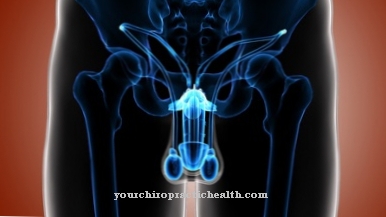Of the Sense of strength or Sense of resistance is a quality of perception of interoceptive depth sensitivity and forms part of the kinaesthetic system. Through the sense of strength, humans can estimate their own effort when moving and thus coordinate tension and pressure. In extrapyramidal lesions, the sense of force is disturbed.
What the sense of strength?

Human perception is divided into interoception and exteroception. Exteroception is the perception of external stimuli. Interoception corresponds to the perception of stimuli from one's own body. Proprioception is a part of interoception. This type of perception encompasses all sensory impressions for perceiving one's own body movements and the position in space.
So-called depth sensitivity is crucial for proprioception. This is the muscular sense (sense of strength), which has different perceptual qualities. In addition to assessing their own muscle strength, the muscular sense allows people to move in a targeted manner against resistance.
The muscle sense enables the movement of individual muscle groups and the perception of pressure distributions. In this way, it enables the dosage of pressure and tension during muscle movement. These perceptual qualities of deep sensitivity are called the sense of force or sense of resistance. Together with the sense of position to perceive the current starting position and the sense of movement to receive the extent of movement or changes in position, the sense of force forms the entirety of the kinaesthetic system.
Function & task
The sense of strength lets people plan the effort required for each muscle contraction precisely and adjust it to the goal of movement. Thanks to this quality of perception, people do not, for example, involuntarily crush an object when reaching for it.
Proprioceptors in the muscles and tendons provide permanent information about the state of tension in the muscles. The proprioceptors include the muscle and tendon spindles. The muscle spindles measure the length of the skeletal muscles. They are formed by intrafusal muscle fibers that have their afferents in nerve fibers of the Ia class. The secondary afferent innervation of the muscle spindles is provided by class II nerve fibers. The efferent innervation of the structures is carried out by gamma motor neurons. Above all, they control the sensitivity of the spindle.
Tendon spindles, in turn, lie between muscle and tendon fibers. They are formed by bundled collagen fibers that are enclosed by a connective tissue capsule. They are connected to the muscle and tendon fibers and are supplied by afferent Ib nerve fibers. As soon as a muscle is contracted and thus shortened, the collagen fibers in the tendon spindles stretch. The spindles then polarize and transmit the stimulus with information on the strength of the stimulus to the spinal cord.
There, the Ib neurons exert an inhibiting influence on the motor neurons of the stimulated muscle through interneurons and stimulate the motor neurons of the respective muscle antagonist. The impulses reach the anterior and posterior spinocerebellar tracts and the cerebellum via ascending nerve tracts.
Through the sense of strength, humans can estimate resistance to movement and estimate the weight of objects. He receives this information based on the muscle tension that occurs during a certain movement. The information acquired is stored in a sensory-specific memory and will help people in the future to precisely coordinate and plan muscle strength as part of a specific movement.
Without the sense of strength, movement planning and strength assessment would not be possible. Without the quality of perception, human movements would be clumsy and not expedient.
The sense of strength is indeed an interoceptive quality of perception, but also contributes to the receptive acquisition of information about the external world. This is especially true for information about the weight of certain objects. Estimates of the weight or the strength of a resistance depend on the muscle strength of the individual and are accordingly subjectively shaped.
You can find your medication here
➔ Medicines for paresthesia and circulatory disordersIllnesses & complaints
So-called extrapyramidal disorders are characteristic of various neurological diseases. With regard to movement disorders, extrapyramidal means a cause outside the pyramidal system. The pyramidal system is the main switching point for all motor skills. It lies in the spinal cord and connects the central motor neurons that play a role in every type of movement. Damage to the pyramidal system can lead to paralysis, muscle weakness or spasticity.
The extrapyramidal system records all movement control processes outside of the pyramidal system. Damage to this system is primarily characterized by a lack of the inhibitory influence that the upper motor neuron exerts to coordinate movements. The movements of patients with extrapyramidal lesions appear to be greatly exaggerated. Any extrapyramidal damage thus affects the sense of strength. Those affected often find the weight of their own limbs heavy and therefore use much more force to perform the smallest movements. Due to the extrapyramidal damage, they have the feeling of always executing movements against resistance. The resistance felt is projected outwards and for this reason causes the patient to use an unnecessarily large amount of force to overcome the resistance. The affected persons are therefore often no longer able to adequately dose pressure and tension. In some cases, the movement is generally slowed down as it occurs against a perceived resistance.
This type of central nerve damage is characteristic of diseases such as multiple sclerosis. It is an autoimmune disease that causes the immune system to cause inflammation in the central nervous system. Neurons often irreversibly die as a result of the inflammation. Movement disorders like the phenomenon described often occur.
In addition to this disease, trauma or spinal cord infarction can also cause the phenomenon described. Another possible cause is tumor diseases of the spine.













.jpg)

.jpg)
.jpg)











.jpg)